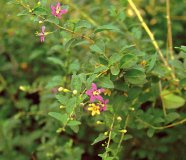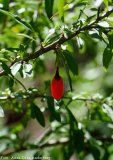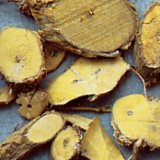Wolfberry Bark
http://www.100md.com
《e Natural Health Center》
 |
 |
 |
 |
Heat Clearing Herbs to Clear Heat of the Deficiency Type
Wolfberry Bark
Latin:
Cortex Lycii Radicis
Origin:
The root-bark of Lycium chinensis Mill. or Lycium barbarum L., a deciduous shrub, of the Solanaceae family. Native to east Asia, the plant is grown in thickets and river banks in lowland in China, Japan, Java, Malaysia, etc., and is now naturalized in Britain, Europe and North America.
, http://www.100md.com
The shrub grows to about 2.5 m by 2 m at a medium rate. It is in flower from June to August. The flowers are hermaphrodite (have both male and female organs) and are pollinated by bees. The plant requires well-drained soil and can grow in nutritionally poor soil. It cannot grow in the shade, however, but can tolerate maritime exposure.
In China, the plant is distributed everywhere in the South and the North. Reaped in early spring or after autumn, the root-bark is peeled off, dried in the sun, cut into sections for later use.
, 百拇医药
Also known as Box Thorn, Chinese Desertthorn, Matrimony Vine, Lycium and Chinese Wolfberry.
See also Yin Tonics, Wolfberry Fruit; Food, Fruits, Wolfberry Fruit; and Food, Vegetables, Wolfberry.
Properties:
Sweet and tasteless in flavor, cold in nature, it is related to the lung, liver and kidney channels.
Functions:
, http://www.100md.com
Removes heat from the blood to relieve hectic fever and clears heat from the lungs to purge fire.
Wolfberry is a major Chinese tonic herb with almost 2,000 years of use. Both the berries and the fruit are used and traditionally the plant is believed to promote long life.
The root-bark is used in the treatment of pulmonary tuberculosis and pneumonia in small children, chronic febrile disease, night sweats, cough and asthma, tuberculosis, hypertension and diabetes mellitus.
, 百拇医药
Applications:
1. To treat fever due to yin deficiency and hectic fever with night sweat:
Use it with windweed rhizome (Rhizoma Anemarrhenae), turtle shell, starwort root (Radix Stellariae), etc., e.g., Digupi Tang.
2. To treat coughing due to lung-heat:
Use it with white mulberry root-bark, licorice, etc., e.g., Xie Bai San.
, http://www.100md.com
3. To treat bleeding ailments due to blood-heat, such as hematemesis, epistaxis, hematuria, etc.:
This herb can be decocted alone in wine or used together with herbs which remove heat from the blood to arrest bleeding, such as cogongrass rhizome (Rhizoma Imperatae), oriental arborvitae twig (Cacumen Biotae), etc.
4. To treat diabetes due to interior heat:
Use it with raw rehmannia, Chinese trichosanthes root, Chinese magnoliavine fruit (Fructus Schisandrae), etc.
, http://www.100md.com
Dosage and Administration:
6-15 g.
Decoct the herb and the other ingredients for drinking.
Cautions on Use:
It should be avoided by those suffering from fever due to affection by exopathogenic wind-cold or by anyone with loose stools due to spleen insufficiency.
Some caution should be exercised with regard to the edible leaves of this species, since it belongs to a family that often contains toxins. However, use of the leaves is well documented and fairly widespread in many areas.
, 百拇医药
Reference Materials:
'Shen Nong's Herbal Classic' :
"Five internal organs affected by pathogenic factors, diabetes due to interior heat and general arthralgia."
'The Pearl Bag' :
"To treat hectic fever with steaming sensation in the skin, diabetes, rheumatism and arthralgia by strengthening bones and muscles and removing heat from the blood."
, 百拇医药
'Materia Medica for Decoctions' :
"Purging the kidneys of fire, suppressing latent fire in the lungs, removing fire from the uterus, relieving fever and replenishing vital energy."
Toxic or Side Effects:
Modern Researches:
The herb contains betaine, beta-sitosterol, linoleic acid, cinnamic acid and a variety of phenolic substances.
, 百拇医药
Betaine can increase the rate of growth of farm animals and increase the weight and amount of eggs. It is used in the treatment of achlorhydria, atherosclerosis and hepatic diseases
The root bark is antibacterial, antipyretic, hepatic, hypoglycaemic and vasodilator. It stimulates the parasympathetic nervous system, which controls involuntary bodily functions such as digestive secretions.
The decoction of this herb can reduce blood pressure and blood sugar, reduce serum cholesterol and stimulate the uterus.
This herb has a more powerful inhibitory effect on typhoid bacillus, alpha-paratyphoid bacillus and Shigella flexnari., 百拇医药